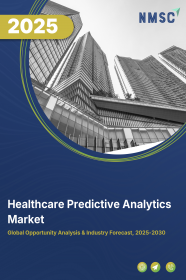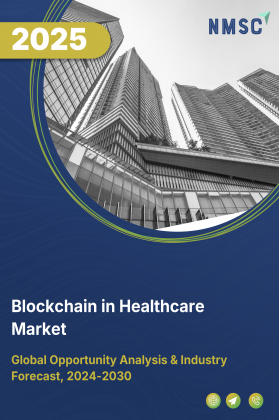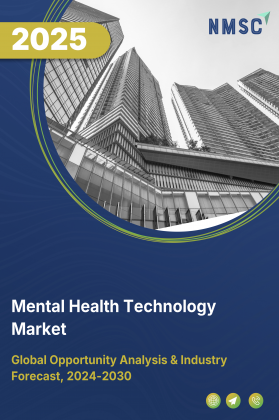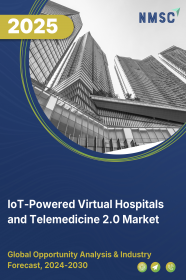
Healthcare Predictive Analytics Market by Component (Hardware, Software, and Services), by Deployment Model (On-Premise and Cloud), by Application (Financial Management, Operational & Administrative Management, and Clinical Management, and Others), and by End User (Healthcare Payers, Healthcare Providers, and Others) - Global Opportunity Analysis and Industry Forecast 2025-2030
Healthcare Predictive Analytics Market Overview
The global Healthcare Predictive Analytics Market size was valued at USD 13.14 billion in 2024 and is predicted to reach USD 61.93 billion by 2030 with a CAGR of 29.6% from 2025-2030.
Healthcare predictive analytics market refers to the industry primarily focused on providing advanced analytical tools and solutions to the healthcare organizations. These tools and solutions control leverage historical and real time data for predict future outcomes, optimize operational efficiency and improved patient care.
Through the integration of enhanced technologies artificial intelligence, machine learning, and big- data analytics, businesses support healthcare providers to predict disease outbreak, personalize treatment plans, reduce cost, manage resources efficiently. This various application of predictive analytics in healthcare includes patient management, risk assessment, financial analytics, and clinical decision support, aimed to enhance the overall quality of the healthcare services.
Market Dynamics and Trends
The increasing generation of healthcare data from electronic health records (EHR), wearable devices, and digital health tracking technologies is driving the healthcare predictive analytics market expansion by enabling deeper insights for improved patient outcomes and operational efficiency.
According to a report published by the National Institute of Health, around 30% of the global data volume is generated by the healthcare industry. Also, the data generated by the healthcare IoT sector is expected to grow at a CAGR of 36% by 2025. This surge in data creates demand for high-tech analytical tools to convert important patient information into actionable insights.
Moreover, the surge in chronic diseases, including diabetes, cardiovascular conditions, and cancer, is driving demand for predictive healthcare solutions by enabling early detection, risk assessment, and effective management strategies.
According to the World Health Organization, noncommunicable diseases (NCD) such as cardiovascular disease accounts for 17.9 billion deaths annually, followed by cancer with 9.3 billion, chronic respiratory diseases with 4.1 billion, and diabetes with 2.0 billion deaths. These tools provide early detection, prevention and effective management of chronic diseases, thus driving the healthcare predictive analytics market demand.
Furthermore, increasing adoption of preventive healthcare is further driving the healthcare predictive analytics market growth by leveraging predictive analytics tools to identify potential health risks early. These tools enable healthcare providers to implement proactive measures, reducing the occurrence of chronic diseases and minimizing long-term healthcare costs, while improving patient outcomes.
As per the report published by the European Union in 2024, the total expenditure on preventive healthcare across all EU Member States reached USD 107.94 billion in 2021. Germany led the expenditure, spending USD 33.98 billion, the highest among all member states, and was the only country to exceed USD 22.65 billion in spending.
Similarly, the Ministry of Commerce and Industry states that, the preventive healthcare sector of India, encompassing areas such as exercise, wellness, foods, supplements, early diagnosis, and health tracking, is expected to reach USD 197 billion by 2025. The growing focus on preventive healthcare is fueling the expansion of the healthcare predictive analytics industry.
However, the data security and privacy concern associated with healthcare predictive analytical tools is restraining the growth of the market. Healthcare data is highly sensitive, containing personal information that must be protected from unauthorized access or breaches. These concerns lead to hesitation among healthcare providers and patients to fully adopt predictive analytics solutions.
On the contrary, the integration of artificial intelligence (AI) and machine learning (ML) algorithms in predictive analytical tools is expected to create ample growth opportunities for the market in the future. These technologies enable more accurate predictions and insights from vast amount of healthcare information, enhancing decision making, reducing cost, and improving patient satisfaction.
For instance, in October 2024, IQVIA launched its AI Assistant powered by healthcare-grade AI, designed to enhance predictive analytics in the healthcare sector. This innovation demonstrates the use of artificial intelligence and machine learning to generate precise insights from vast healthcare data, improving decision-making, reducing costs, and enhancing patient satisfaction.
Market Segmentation and Scope of the Study
The healthcare predictive analytics market report is segmented on the basis of component, deployment, application, end-user, and region. On the basis of component, the market is classified into hardware, software, and services. Based on deployment, the market is classified into on-premise and cloud. On the basis of application, the market is categorized into financial management, operational & administrative management, and clinical management. On the basis of end-user, the market is segmented into healthcare payers, healthcare providers, and others. Regional breakdown and analysis of each of the aforesaid segments includes regions comprising of North America, Europe, Asia-Pacific, and RoW.
Geographical Analysis
North America dominates the healthcare predictive analytics market share and is expected to continue its dominance during the forecast period. This is attributed to the rising healthcare expenditure in that is driving the predictive analytics for healthcare market as providers seek cost management solutions.
According to the Organisation for Economic Co-operation and Development report, the healthcare expenditure in the U.S. were USD 12,555 per person in 2022, that was higher than the other high-income countries. Thus, the healthcare providers in this region are adopting predictive analytic tools to manage cost while maintaining quality patient care, driving the market growth in the region.
Also, the rising number of chronic diseases such as diabetes, cancer, and cardiovascular diseases in the region is further driving the demand for healthcare data management tools as these tools help healthcare providers to predict patient risks early, enabling proactive interventions to improve patient outcomes and manage the increasing healthcare burden associated with these conditions.
As per the American Hospital Association (AHA), 133 million Americans currently suffer from at least one chronic illness, a 15 million increase over the past decade. By 2030, this number is expected to rise to 170 million, reflecting a growing prevalence of conditions such as hypertension, heart disease, and arthritis. This surge is significantly boosting the market in the region for early detection, prevention, and management of diseases along with enhanced patient care.
On the other hand, Asia-Pacific is expected to show a steady rise in the healthcare predictive analytics industry due to the growing digital health ecosystem. Increasing adoption of telemedicine, wearable devices, and health apps across the region generates a vast amount of healthcare data. This expansion fuels the demand for predictive analytics tools that process and analyze this data, enabling healthcare providers to enhance patient care, streamline operations, and improve overall healthcare outcomes.
As per the Invest India, Japan's digital health market is projected to generate industry revenue of USD 27.4 billion by 2025. This growth in the sector accelerates the demand for advance predictive analytics tools.
Moreover, the governments across the Asia-Pacific region are implementing initiatives and policies to promote healthcare IT adoption and data-driven healthcare solutions. These efforts include funding for digital health infrastructure, setting up regulatory frameworks to ensure data security, and providing incentives for healthcare providers to adopt advanced technologies.
For instance, initiatives such as Ayushman Bharat Digital Mission, CoWIN App, Aarogya Setu, e-Sanjeevani, e-Hospital made health care facilities and services reach every corner of India. These initiatives bridge the existing gap among different stakeholders of the healthcare ecosystem through digital highways. Therefore, the increasing government initiatives to improve healthcare delivery, enhance patient outcomes, and reduce overall healthcare costs drives the healthcare predictive analytics market in the region.
Competitive Landscape
The healthcare predictive analytics industry comprises of various key market players including Optum, Inc., Oracle, IBM, Health Catalyst, McKesson Medical-Surgical Inc., OSP Labs, SAS Institute Inc., GE HealthCare, Inovalon, Merative, Mede Analytics, CorroHealth, Inc., CitiusTech Inc., Cloudera, Inc., IQVIA Inc, and others. These market players are adopting strategies such as product launches across various regions to maintain their dominance in the global market.
For instance, in October 2024, Oracle launched AI-powered Oracle Analytics Intelligence for Life Sciences to improve predictive analytics in healthcare. The platform was designed to help organizations analyze large healthcare and life sciences datasets, enhancing clinical trials, drug development, and patient care.
Moreover, in November 2023, GE Healthcare launched an initiative to validate AI models that predict patient outcomes, aiming to improve clinical decision-making and patient care. This effort focused on enhancing healthcare predictions, improving resource management, and optimizing patient outcomes by integrating AI-driven healthcare analytics.
Furthermore, in September 2023, SAS launched Viya Health Data Analytics solution, integrating AI and data analytics to improve healthcare decision-making. The solution helps predict patient outcomes, optimize healthcare operations, and enhance care quality by providing real-time, actionable insights.
Key Benefits
-
The report provides quantitative analysis and estimations of the healthcare predictive analytics market from 2025 to 2030, which assists in identifying the prevailing industry opportunities.
-
The study comprises a deep-dive analysis of the current and future healthcare predictive analytics market trends, to depict prevalent investment pockets in the industry.
-
Information related to key drivers, restraints, and opportunities and their impact on the healthcare predictive analytics market is provided in the report.
-
Competitive analysis of the key players, along with their market share is provided in the report.
-
Value chain analysis in the market study provides a clear picture of roles of stakeholders.
Healthcare Predictive Analytics Market Key Segments
By Component
-
Hardware
-
Software
-
Services
By Deployment Model
-
On-Premise
-
Cloud
-
By End User
-
Healthcare Payers
-
Healthcare Providers
-
Others
By Region
-
North America
-
The U.S.
-
Canada
-
Mexico
-
-
Europe
-
The UK
-
Germany
-
France
-
Italy
-
Spain
-
Denmark
-
Netherlands
-
Finland
-
Sweden
-
Norway
-
Russia
-
Rest of Europe
-
-
Asia-Pacific
-
China
-
Japan
-
India
-
South Korea
-
Australia
-
Indonesia
-
Singapore
-
Taiwan
-
Thailand
-
Rest of Asia-Pacific
-
-
RoW
-
Latin America
-
Middle East
-
Africa
-
Key Players
-
Optum, Inc.
-
Oracle
-
IBM
-
Health Catalyst
-
McKesson Medical-Surgical Inc.
-
OSP Labs
-
SAS Institute Inc.
-
GE HealthCare
-
Inovalon
-
Merative
-
Mede Analytics
-
CorroHealth, Inc.
-
CitiusTech Inc.
-
Cloudera, Inc.
-
IQVIA Inc.
REPORT SCOPE AND SEGMENTATION:
|
Parameters |
Details |
|
Market Size in 2024 |
13.14 billion |
|
Revenue Forecast in 2030 |
61.93 billion |
|
Growth Rate |
29.6% from 2025 to 2030 |
|
Analysis Period |
2024–2030 |
|
Base Year Considered |
2024 |
|
Forecast Period |
2025–2030 |
|
Market Size Estimation |
Billion (USD) |
|
Growth Factors |
|
|
Countries Covered |
28 |
|
Companies Profiled |
15 |
|
Market Share |
Available for 10 companies |
|
Customization Scope |
Free customization (equivalent to up to 80 working hours of analysts) after purchase. Addition or alteration to country, regional, and segment scope. |
|
Pricing and Purchase Options |
Avail customized purchase options to meet your exact research needs. |




















 Speak to Our Analyst
Speak to Our Analyst

























